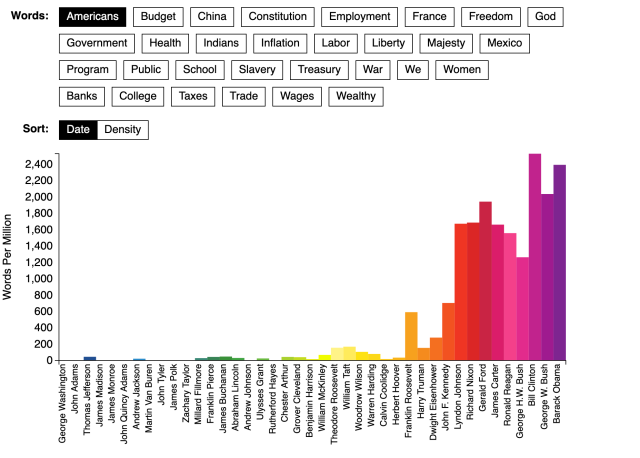“He shall from time to time give to the Congress Information of the State of the Union,” stipulates Article Two of the Constitution, “and recommend to their Consideration such Measures as he shall judge necessary and expedient.”
Since 1790, every president has made an annual report to Congress, highlighting the challenges and opportunities facing the nation. Presidents from Jefferson to Taft dispatched lengthy written addresses; since Wilson, most have emulated Washington’s example and delivered shorter remarks in person. Using the Bookworm platform for text analysis, we’ve combed through the full texts of all 224 State of the Union addresses and ranked the frequency with which each president used each word.
We invite you to explore these speeches. Click on any individual word and observe how frequently each president employed it. Sort by DATE to see how the word’s use has evolved over time, and by DENSITY to rank the presidents by their propensity to use that particular word. Click on any of the colored bars to summon a list of all the times that the corresponding president used the word in a State of the Union address. Then scroll down below the graph and see how our team of historians interprets what this chart reveals, and what it may conceal.

FREEDOM: Perhaps the defining value of American society, the word is surprisingly rare in the nation's first century. It appears only once in the Constitution, and early presidents used it sparingly. Not until FDR placed the "Four Freedoms" at the heart of his 1941 State of the Union did the term become a staple of presidential rhetoric. Since then, it has flourished, but with a noticeably partisan tilt: the four presidents to use it the most are Eisenhower, Reagan, and the Bushes. To date, Obama has used it less frequently than any president since Warren Harding. -Benjamin Schmidt
PUBLIC: It was among the most common words in the earliest State of the Union addresses, reflecting the language of self-government in the early republic. Debts, lands, currency, and roads were all public trusts, administered rather than owned by the government. More recent presidents speak of the public only a tenth as much, and then mostly in reference to public schools. In the last 70 years, some of what was once public has been apportioned to either directly to the government or to the American people. The shift may mark a change in the speech’s audience as well; while presidents previously exhorted Congress on the public’s behalf, now they speak more directly to the people about what government can or cannot do for them. -Benjamin Schmidt